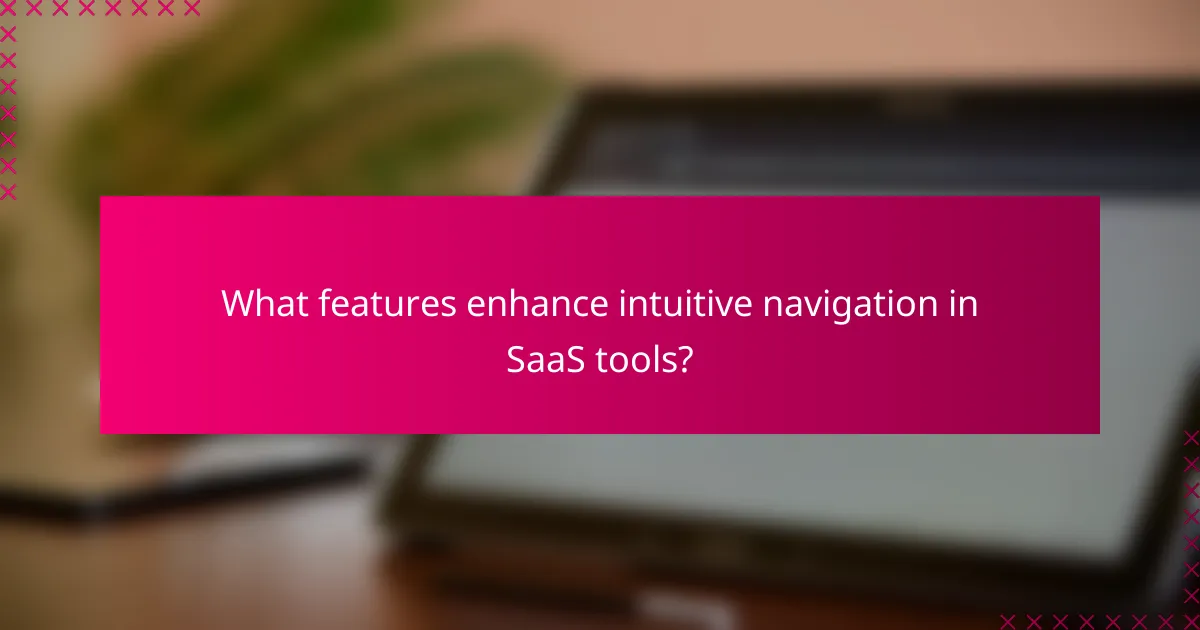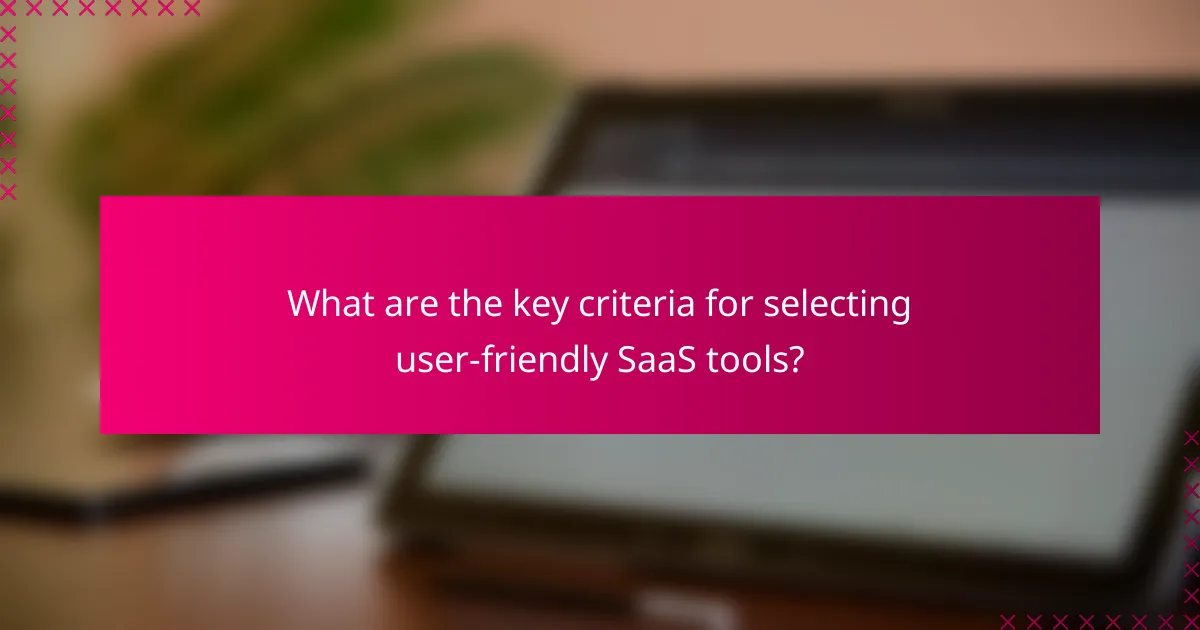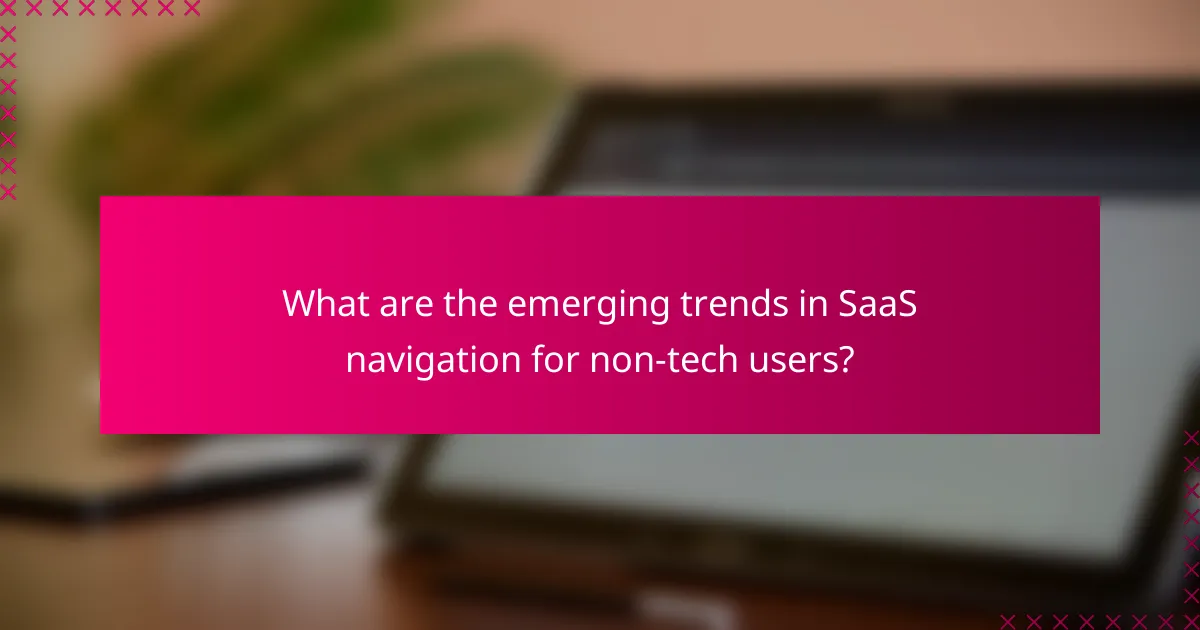SaaS tools are designed to enhance navigation for non-tech savvy users by offering simplified interfaces and intuitive designs that minimize complexity. Features like drag-and-drop functionality and customizable dashboards allow users to easily find what they need, making software more accessible and user-friendly. Platforms such as Monday.com, Asana, and Trello exemplify this approach, providing straightforward navigation that empowers users to manage projects and collaborate effectively without requiring extensive technical skills.

How can SaaS tools improve navigation for non-tech savvy users?
SaaS tools can enhance navigation for non-tech savvy users by providing simplified interfaces and intuitive designs that reduce complexity. These features help users easily find what they need without requiring extensive technical knowledge.
User-friendly interfaces
User-friendly interfaces are essential for making SaaS tools accessible to everyone. These interfaces often feature clear labels, straightforward menus, and visually appealing layouts that guide users through the software. For instance, a dashboard with large icons and minimal text can help users quickly identify functions without feeling overwhelmed.
Additionally, incorporating responsive design ensures that the interface works well on various devices, such as smartphones and tablets. This flexibility allows users to navigate the software comfortably, regardless of their preferred device.
Intuitive design principles
Intuitive design principles focus on creating a seamless user experience by anticipating user needs. This can include using familiar symbols, consistent navigation paths, and logical grouping of related functions. For example, placing frequently used features in easily accessible locations can significantly reduce the time users spend searching for tools.
Moreover, employing visual hierarchy—where important elements stand out—can guide users naturally through tasks. Using contrasting colors for buttons or highlighting key actions can help users understand where to click next.
Accessible help resources
Accessible help resources are crucial for supporting non-tech savvy users as they navigate SaaS tools. Providing comprehensive tutorials, FAQs, and user guides can empower users to solve problems independently. Video tutorials, in particular, can be effective, as they visually demonstrate how to use various features.
Additionally, integrating in-app support, such as chatbots or live chat options, can offer immediate assistance. This ensures that users have access to help when they encounter difficulties, enhancing their overall experience with the software.

What features enhance intuitive navigation in SaaS tools?
Intuitive navigation in SaaS tools is primarily enhanced by features that simplify user interactions and improve accessibility. Key elements such as drag-and-drop functionality, customizable dashboards, and searchable knowledge bases make it easier for non-tech savvy users to navigate and utilize the software effectively.
Drag-and-drop functionality
Drag-and-drop functionality allows users to easily move elements within the software interface, making tasks more straightforward. For example, users can rearrange items on a dashboard or upload files simply by dragging them into the application. This feature reduces the learning curve and enhances user satisfaction.
When implementing drag-and-drop, ensure that the interface provides clear visual feedback, such as highlighting drop zones. Avoid overly complex actions that may confuse users, and consider providing tooltips or guides to assist first-time users.
Customizable dashboards
Customizable dashboards enable users to tailor their workspace according to their specific needs and preferences. Users can select which widgets or data visualizations to display, allowing them to focus on the most relevant information. This personalization fosters a sense of ownership and improves overall usability.
To enhance the customization experience, offer a variety of widgets and layout options. Encourage users to experiment with different configurations and provide easy reset options if they want to revert to default settings. Regularly solicit user feedback to refine available customization features.
Searchable knowledge bases
Searchable knowledge bases provide users with quick access to help articles, tutorials, and FAQs, facilitating self-service support. A well-organized knowledge base can significantly reduce the time users spend searching for solutions to common issues. This feature is particularly beneficial for non-tech savvy users who may feel overwhelmed by technical jargon.
Ensure that the knowledge base is easy to navigate, with a robust search function that returns relevant results. Consider categorizing content by topic and including multimedia elements like videos or infographics to cater to different learning styles. Regularly update the knowledge base to reflect new features and user feedback.

Which SaaS tools are best for non-tech savvy users in the UK?
For non-tech savvy users in the UK, tools like Monday.com, Asana, and Trello stand out for their intuitive interfaces and straightforward navigation. These platforms simplify project management, making it easy for anyone to track tasks and collaborate without needing extensive technical knowledge.
Monday.com
Monday.com offers a visually appealing interface that allows users to manage projects through customizable boards. Its drag-and-drop functionality makes it easy to assign tasks, set deadlines, and track progress, which is particularly helpful for those unfamiliar with complex software.
Users can choose from various templates tailored to different industries, ensuring they can quickly set up their workflows. The platform also provides automation features that help reduce repetitive tasks, making it a practical choice for non-tech savvy individuals.
Asana
Asana is designed with simplicity in mind, featuring a clean layout that helps users focus on their tasks. It allows users to create projects, assign tasks, and set due dates with minimal effort. The user-friendly interface makes it easy for anyone to get started without a steep learning curve.
Asana’s ability to integrate with other tools, such as Google Drive and Slack, enhances its functionality while keeping the user experience straightforward. For those new to project management software, Asana’s guided tutorials can provide additional support.
Trello
Trello uses a card-based system that is intuitive and visually engaging, making it easy for users to organize their tasks. Each card can represent a task, and users can move these cards across different lists to indicate progress, which is particularly helpful for visual learners.
The platform is flexible, allowing users to customize boards with labels, due dates, and checklists. Trello also offers a range of power-ups that can enhance its capabilities without complicating the user experience, making it a great option for those who prefer simplicity.

What are the key criteria for selecting user-friendly SaaS tools?
When selecting user-friendly SaaS tools, prioritize ease of onboarding, customer support availability, and integration capabilities. These criteria ensure that non-tech savvy users can effectively navigate and utilize the software without significant hurdles.
Ease of onboarding
Ease of onboarding is crucial for non-technical users, as it determines how quickly they can start using the software. Look for tools that offer guided tutorials, intuitive interfaces, and clear documentation to facilitate a smooth transition.
Consider platforms that provide interactive walkthroughs or onboarding checklists. These features can significantly reduce the time it takes for users to become proficient, often within a few hours to a couple of days.
Customer support availability
Accessible customer support is essential for users who may encounter challenges while using the software. Evaluate the support options available, such as live chat, email, or phone assistance, and their operating hours.
Tools that offer 24/7 support or extensive knowledge bases can greatly enhance the user experience. Ensure that the support team is responsive and knowledgeable to address any issues promptly.
Integration capabilities
Integration capabilities allow SaaS tools to work seamlessly with other software applications, enhancing their functionality. Check whether the tool can connect with commonly used platforms, such as CRM systems or project management tools.
Look for solutions that offer pre-built integrations or APIs, as these can simplify workflows and reduce manual data entry. Tools that support popular integrations can save users time and improve overall efficiency.

How do user feedback and testing improve SaaS navigation?
User feedback and testing significantly enhance SaaS navigation by identifying pain points and optimizing user experience. By actively engaging with users, developers can make informed adjustments that lead to more intuitive interfaces.
Iterative design improvements
Iterative design improvements involve continuously refining the navigation based on user insights. This process typically includes collecting feedback after each version release, allowing teams to address specific issues that users encounter. For instance, if users struggle to locate features, developers can reorganize menus or enhance labeling.
Employing A/B testing can also be beneficial, where two versions of a navigation layout are tested with real users to determine which performs better. This method ensures that changes are data-driven rather than based on assumptions.
Real-world user testing
Real-world user testing is crucial for understanding how actual users interact with SaaS navigation. Conducting usability tests with a diverse group of participants can reveal unexpected challenges and preferences. Observing users as they navigate the platform provides insights that surveys or interviews may not capture.
To maximize effectiveness, consider scheduling regular testing sessions throughout the development cycle. Aim for a mix of experienced and novice users to gather a wide range of feedback. This approach helps ensure that the navigation is accessible to both tech-savvy and non-tech-savvy individuals.

What are the emerging trends in SaaS navigation for non-tech users?
Emerging trends in SaaS navigation focus on making tools more accessible for non-tech savvy users. This includes intuitive designs and features that simplify the user experience, allowing individuals to navigate software without extensive technical knowledge.
AI-driven assistance
AI-driven assistance is increasingly being integrated into SaaS platforms to help non-tech users navigate complex functionalities. These systems can provide real-time support, answer queries, and guide users through tasks, reducing frustration and enhancing usability.
For instance, chatbots can offer step-by-step instructions or suggest actions based on user behavior. This personalized support can significantly decrease the learning curve, allowing users to become proficient more quickly.
Personalized user experiences
Personalized user experiences are crucial for engaging non-tech savvy users in SaaS applications. By tailoring interfaces and features to individual preferences, software can create a more intuitive navigation experience that resonates with users.
For example, platforms may allow users to customize their dashboards or receive recommendations based on their usage patterns. This level of personalization not only improves satisfaction but also encourages users to explore more features confidently.
